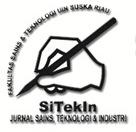Expert System Application Design for Diagnosing Damage to The Charger Rectifier Panel with A Website-Based Forward Chaining Method
Abstract
In the increasingly complex world of work, as technology and information continue to evolve, there is a need for a medium that can leverage information to support business processes or activities in an organization, making them more effective and efficient. PT. Swadaya Engineering, a company operating in the electrical and telecommunications industry located in South Jakarta, is facing a problem of frequent damage reports on rectifier charger panels that are difficult to convey manually through phone calls. This constraint is a hindrance to improving the effectiveness and efficiency of the company, causing customer dissatisfaction due to a lack of information obtained. To address this issue, the author developed an expert system application for diagnosing rectifier charger panel damage based on a website using forward chaining as the application development method. The purpose of designing this application is to improve the effectiveness and efficiency of the company in delivering information on rectifier charger panel damage and increasing customer satisfaction in diagnosing such damage. It is expected that this expert system application will be an effective medium for the company to leverage information and support business processes or activities that are carried out.
Full Text:
PDFReferences
N. Farzaneh, “A hierarchical expert-guided machine learning framework for clinical decision support systems: an application to traumatic brain injury prognostication,” npj Digit. Med., vol. 4, no. 1, 2021, doi: 10.1038/s41746-021-00445-0.
Y. Tian, “ZSLF: A New Soft Likelihood Function Based on Z-Numbers and Its Application in Expert Decision System,” IEEE Trans. Fuzzy Syst., vol. 29, no. 8, pp. 2283–2295, 2021, doi: 10.1109/TFUZZ.2020.2997328.
D. Lin, “Application of Comprehensive Artificial intelligence Retinal Expert (CARE) system: a national real-world evidence study,” Lancet Digit. Heal., vol. 3, no. 8, 2021, doi: 10.1016/S2589-7500(21)00086-8.
A. Saibene, “Expert systems: Definitions, advantages and issues in medical field applications,” Expert Systems with Applications, vol. 177. 2021. doi: 10.1016/j.eswa.2021.114900.
A. Mottahedi, “Resilience estimation of critical infrastructure systems: Application of expert judgment,” Reliab. Eng. Syst. Saf., vol. 215, 2021, doi: 10.1016/j.ress.2021.107849.
A. K. Kirgizov, “Expert system application for reactive power compensation in isolated electric power systems,” Int. J. Electr. Comput. Eng., vol. 11, no. 5, pp. 3682–3691, 2021, doi: 10.11591/ijece.v11i5.pp3682-3691.
M. Azarafza, “Application of fuzzy expert decision-making system for rock slope block-toppling modeling and assessment: a case study,” Model. Earth Syst. Environ., vol. 7, no. 1, pp. 159–168, 2021, doi: 10.1007/s40808-020-00877-9.
A. Sarazin, “Expert system dedicated to condition-based maintenance based on a knowledge graph approach: Application to an aeronautic system,” Expert Syst. Appl., vol. 186, 2021, doi: 10.1016/j.eswa.2021.115767.
M. Sridharan, “Application of fuzzy logic expert system in predicting cold and hot fluid outlet temperature of counter-flow double-pipe heat exchanger,” Advanced Analytic and Control Techniques for Thermal Systems with Heat Exchangers. pp. 307–323, 2020. doi: 10.1016/B978-0-12-819422-5.00014-1.
W. A. Abbasi, “COVIDC: An expert system to diagnose COVID-19 and predict its severity using chest CT scans: Application in radiology,” Informatics Med. Unlocked, vol. 23, 2021, doi: 10.1016/j.imu.2021.100540.
M. Sridharan, “Short review on various applications of fuzzy logic-based expert systems in the field of solar energy,” International Journal of Ambient Energy, vol. 43, no. 1. pp. 5112–5128, 2022. doi: 10.1080/01430750.2021.1927839.
A. Heiß, “Modeling and simulation of a multi-parametric fuzzy expert system for variable rate nitrogen application,” Comput. Electron. Agric., vol. 182, 2021, doi: 10.1016/j.compag.2021.106008.
H. Salem, “A systematic review of the applications of Expert Systems (ES) and machine learning (ML) in clinical urology,” BMC Med. Inform. Decis. Mak., vol. 21, no. 1, 2021, doi: 10.1186/s12911-021-01585-9.
L. Li, “Expert consensus on the application of artificial liver blood purification system in the treatment of severe and critical COVID-19,” Chinese J. Clin. Infect. Dis., vol. 13, no. 1, pp. 1–3, 2020, doi: 10.3760/cma.j.issn.1674-2397.2020.01.001.
Z. Gang, “Expert consensus on clinical application of metagenomic next-generation sequencing of cerebrospinal fluid in the diagnosis of infectious diseases of the central nervous system,” Chinese J. Neurol., vol. 54, no. 12, pp. 1234–1240, 2021, doi: 10.3760/cma.j.cn113694-20210730-00532.
H. K. Mamidi, “Application of modified SeDeM expert diagram system for selection of direct compression excipient for liquisolid formulation of Neusilin® US2,” J. Drug Deliv. Sci. Technol., vol. 64, 2021, doi: 10.1016/j.jddst.2021.102506.
B. Chudasama, “Target-scale prospectivity modeling for gold mineralization within the Rajapalot Au-Co project area in northern Fennoscandian Shield, Finland. Part 1: Application of knowledge-driven- and machine learning-based-hybrid- expert systems for exploration targeting and addressing model-based uncertainties,” Ore Geol. Rev., vol. 147, 2022, doi: 10.1016/j.oregeorev.2022.104937.
A. Musaev, “MULTI-EXPERT SYSTEMS: FUNDAMENTAL CONCEPTS AND APPLICATION EXAMPLES,” J. Theor. Appl. Inf. Technol., vol. 100, no. 2, pp. 336–348, 2022, [Online]. Available: https://api.elsevier.com/content/abstract/scopus_id/85124474678
O. Varlamov, “‘Brains’ for Robots: Application of the Mivar Expert Systems for Implementation of Autonomous Intelligent Robots,” Big Data Res., vol. 25, 2021, doi: 10.1016/j.bdr.2021.100241.
S. Srivastava, “Application of an expert system of X- ray micro computed tomography imaging for identification of Sitophilus oryzae infestation in stored rice grains,” Pest Manag. Sci., vol. 76, no. 3, pp. 952–960, 2020, doi: 10.1002/ps.5603.
M. Tavana, “A practical review and taxonomy of fuzzy expert systems: methods and applications,” Benchmarking, vol. 27, no. 1. pp. 81–136, 2020. doi: 10.1108/BIJ-04-2019-0178.
J. Rodger, “An expert system gap analysis and empirical triangulation of individual differences, interventions, and information technology applications in alertness of railroad workers,” Expert Syst. Appl., vol. 144, 2020, doi: 10.1016/j.eswa.2019.113081.
DOI: http://dx.doi.org/10.24014/sitekin.v20i2.22698
Refbacks
- There are currently no refbacks.
Copyright (c) 2023 SITEKIN: Jurnal Sains, Teknologi dan Industri
 | Editorial Address: FAKULTAS SAINS DAN TEKNOLOGI UIN SULTAN SYARIF KASIM RIAU Kampus Raja Ali Haji Gedung Fakultas Sains & Teknologi UIN Suska Riau Jl.H.R.Soebrantas No.155 KM 18 Simpang Baru Panam, Pekanbaru 28293 © 2023 SITEKIN, ISSN 2407-0939 |
SITEKIN Journal Indexing:
Google Scholar | Garuda | Moraref | IndexCopernicus | SINTA

SITEKIN by http://ejournal.uin-suska.ac.id/index.php

.png)





